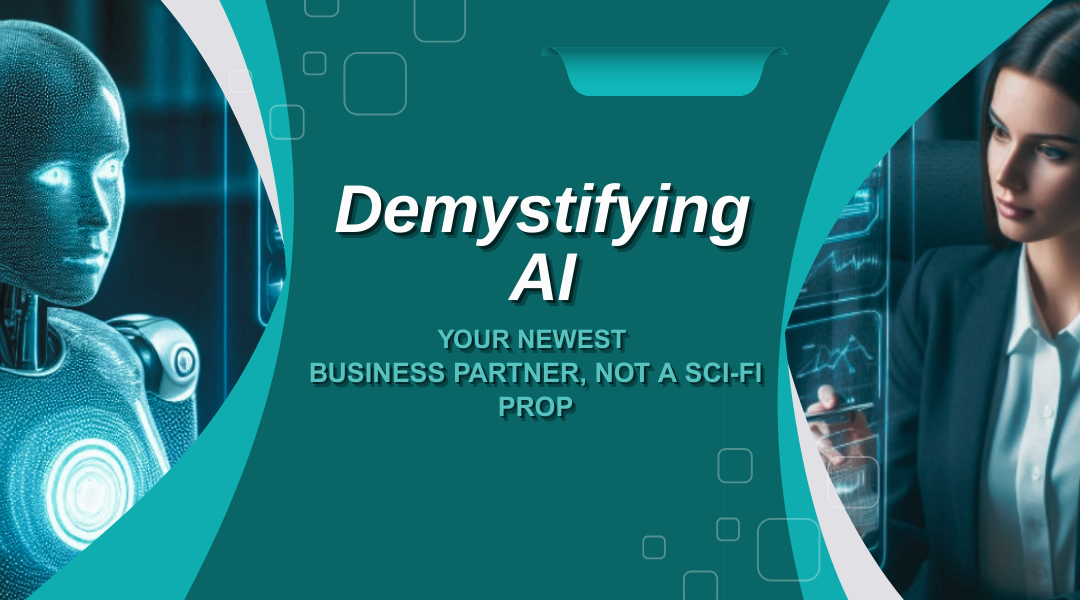If the term “Artificial Intelligence” makes you picture complex code or Hollywood androids, it’s time for a reframe. For a business leader, AI isn’t a futuristic fantasy; it’s a practical, powerful tool already reshaping how we work. Think of it less as a technology and more as a new kind of colleague—one with a unique and incredibly valuable set of skills.
Beyond the Hype: What AI Actually Does for You
Strip away the jargon, and AI’s function is straightforward: it’s a system designed to find meaning in data and act on it. Its true power lies in its scale and speed. While a human can analyze a spreadsheet, AI can analyze every single customer interaction your company has ever had—and spot the subtle trends hidden within.
A more fitting analogy than a robot is a supremely talented analyst. Imagine someone who:
- Never sleeps and can process information millions of times faster than any human team.
- Spots connections you’d never see, like noticing that customers who buy Product A on a rainy Tuesday afternoon are highly likely to also subscribe to Service B.
- Works in real-time, capable of personalizing a website visitor’s experience before they’ve even finished loading the page.
This isn’t about creating consciousness; it’s about leveraging computational power to make smarter, faster, and more informed decisions.
The Game-Changer: Generative AI
The most transformative development for business owners is Generative AI. This is the branch of AI that doesn’t just analyze—it creates.
Consider the tedious tasks that consume your team’s time:
- Writing: Drafting every product description, email campaign, or social post from scratch.
- Designing: Sourcing stock images or creating basic graphics for presentations and ads.
- Brainstorming: Generating initial ideas for marketing angles, blog topics, or even business strategies.
Generative AI automates the initial “blank page” phase of these tasks. Tools like ChatGPT or Midjourney act as a creative and strategic instigator. You provide the direction and the context; they provide a first draft, a mock-up, or a list of possibilities. This doesn’t replace human creativity; it accelerates it, freeing you and your team to focus on strategy, refinement, and high-level creative direction.
Why the “How” is Irrelevant (For Now)
You drive a car without understanding combustion engineering. You use a smartphone without knowing how semiconductors work. The same principle applies here. The immense complexity of machine learning models is the concern of the developers who build them.
Your focus, as a business operator, should be on application, not algorithm. Your expertise lies in knowing your business, your customers, and your goals. AI provides the leverage. Your job is to know what lever to pull and when. It’s about becoming a proficient “conductor” of an AI orchestra, guiding the tools to produce the results that drive your business forward.
Putting It Into Practice: A Quick Scenario
Imagine you run a local coffee roastery. A generative AI tool could:
- Analyze last year’s sales data and weather patterns to predict next month’s demand for iced coffee.
- Draft ten different email subject lines for your new seasonal blend, optimized for higher open rates.
- Generate a stunning image of your coffee bag on a rustic wooden table for your website banner, based on a simple description.
The human touch—selecting the best subject line, approving the final image, and using the demand prediction to place orders—remains irreplaceably yours.
Conclusion: AI as an Amplifier, Not a Replacement
The arrival of practical AI is not a signal to replace your team, but to empower them. It amplifies human intelligence by handling the repetitive, data-heavy lifting that bogs down innovation. It’s the tool that allows your talented employees to spend more time on the work that truly requires a human touch: building relationships, exercising strategic judgment, and crafting a brand experience that resonates on a personal level.
Embracing AI isn’t about becoming a tech expert; it’s about becoming a more effective leader. It’s about recognizing that the most powerful competitive advantage lies in the synergy between human intuition and machine intelligence. The businesses that will thrive are those that learn to partner with this new capability, using it to work smarter, create faster, and understand their customers more deeply than ever before.
Takeaway: Modern AI is a versatile capability that excels at analyzing data at scale and generating content. For business leaders, its true value is as a force multiplier that handles intensive analytical and creative tasks, freeing up human talent to focus on high-level strategy, emotional intelligence, and nuanced decision-making. Success lies in integrating AI as a collaborative partner in your workflow.
